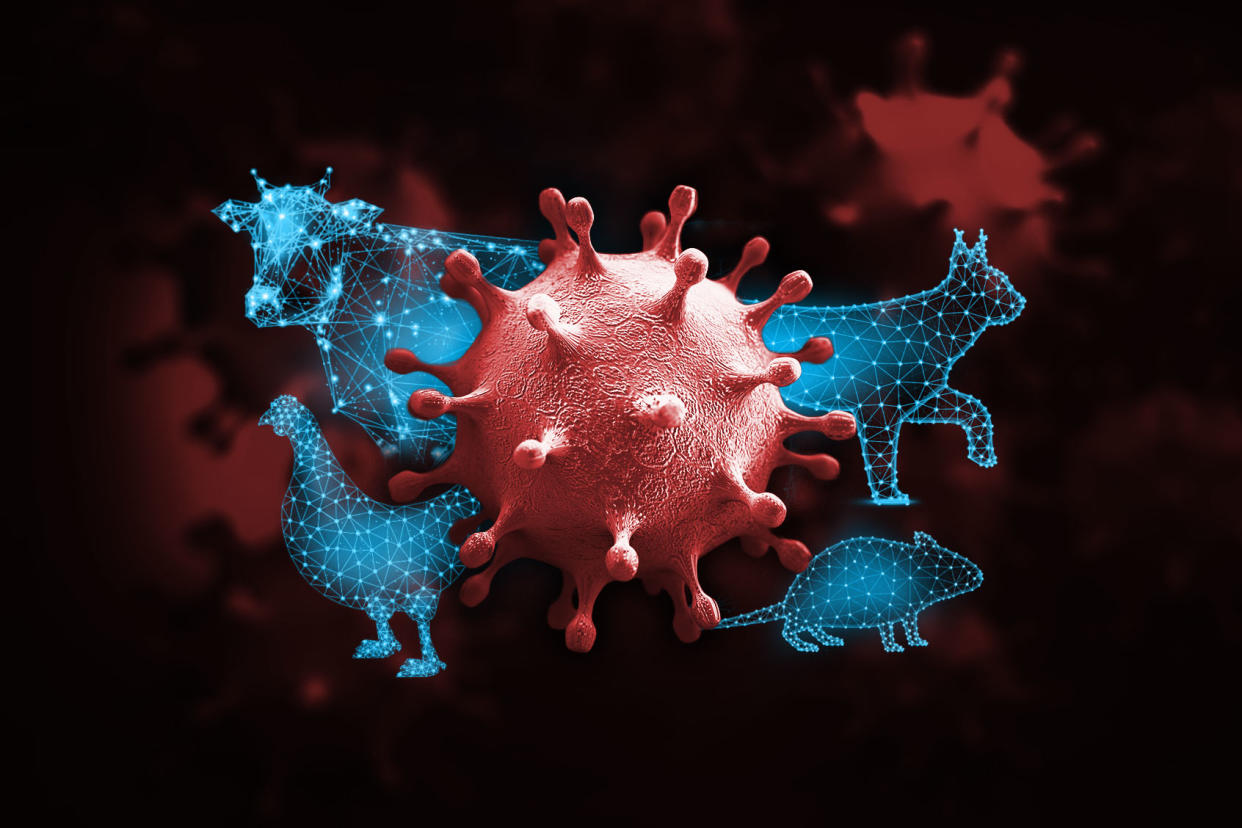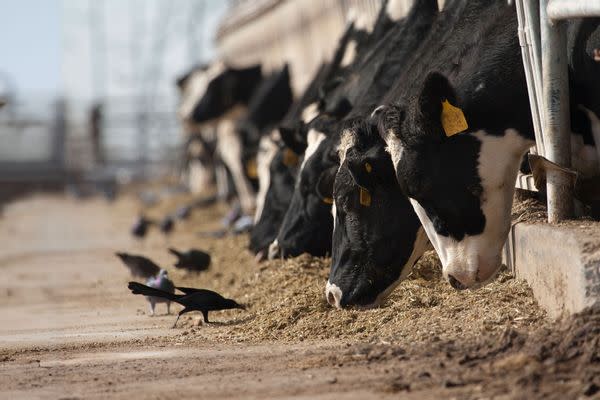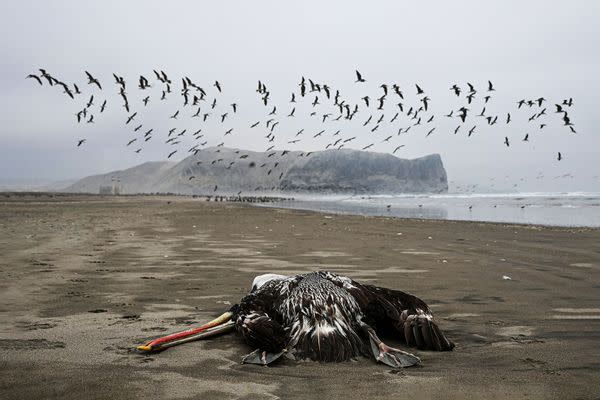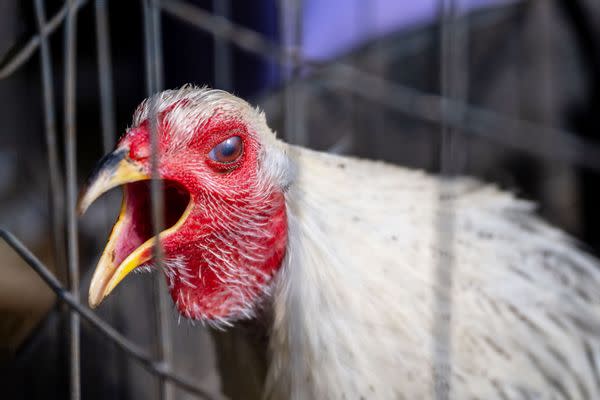Experts say bird flu is a Pandora's box. Are we about to open it?

On the heels of the COVID-19 pandemic, a different virus threatens to cause widespread illness and death, bring the global economy to its knees and throw us back into the chaos that we seemingly just emerged from with the virus SARS-CoV-2. That pathogen is, of course, bird flu or avian influenza, especially the H5N1 strain.
While we’re not there yet, nearly all the conditions are ripe for a new pandemic. H5N1 is seemingly everywhere we look. It's in wild birds, factory farm birds, cats, mice and traces of it have shown up in milk thanks to hundreds, if not thousands, of dairy cows that have become the new focal point in this unwinding crisis. But a lot of open questions remain, including if we have the capacity to stop it in time.
Bird flu is far from being a new pathogen. Whispers of a “fowl plague” date back to the late 19th Century, while H5N1 specifically was first detected in 1996 in Chinese geese. A year later, H5N1 virus outbreaks were detected in poultry in Hong Kong, infecting 18 people and killing six. That’s around when virologists and public health experts noticed H5N1 is a particularly nasty bug with broad pandemic potential and have been closely monitoring it ever since.
Over the years, it has sprung up and disappeared again and again, infecting about 900 people, killing 463 to date. That gives it a severe death rate of 52%, according to the World Health Organization.
But our current situation — the one that is becoming increasingly harder to ignore — really began about three years ago, when bird flu began spreading rapidly in wild birds, massacring millions of them. It alarmed experts who reported it even threatened to wipe out entire colonies of penguins in Antarctica. But it became even more alarming when the virus began spreading more easily in mammals. It killed hundreds of sea lions and walruses, but also began to kill house cats and other wild animals.

This is concerning because spreading in mammals means it’s more likely to infect humans. The 1918 swine flu virus H1N1, which killed an estimated 20 million people, had both mammalian and avian genetics. For context, SARS-CoV-2, the virus behind COVID, has infected approximately 775 million people globally and has so far killed about 7 million people, giving it around a 1% death rate. (COVID is no longer surveilled as much as before, however, so these numbers are most likely an undercount.)
And now things in the U.S. have seemingly reached a crescendo, in which dairy cows are harboring the virus, spreading it amongst each other and even killing cows in some instances. So far, outbreaks in more than 100 dairy farms in 12 states have been reported, but experts have said that cases are likely flying under the radar. So far this year, three Americans have been infected by H5N1 viruses that started in cows, and all of them recovered, but some experts say that patients may be avoiding doctors or refusing tests.
Naturally, another pandemic emerging is a huge risk. But how severe is this situation really? And what can be done to make sure it doesn’t reach a devastating worst case scenario?
Is this officially a pandemic yet?
The definition of a “pandemic” varies. An epidemiology dictionary defines a pandemic as one step above an epidemic, which is sudden, widespread occurrence of infectious disease. According to this definition, an influenza pandemic would occur when “almost simultaneous transmission takes place worldwide.”
When H1N1 began to spread in 2009, experts characterized it as a pandemic due to its proliferation across both hemispheres. The WHO has three criteria that must be met in order for a pandemic to be declared: First, it must be a new strain that has not circulated among humans before. So while HIV was a pandemic in the ‘80s, today it is not considered such. Second, it must infect humans and cause serious illness. Lastly, it must spread efficiently among humans.
Want more health and science stories in your inbox? Subscribe to Salon's weekly newsletter Lab Notes.
“B3.13, [the bird flu strain] that's circulating among dairy cattle certainly checks one box,” Dr. Rajendram Rajnarayanan of the New York Institute of Technology campus in Jonesboro, Ark., told Salon. “If we let this strain circulate uncontrolled, then boxes 2 and 3 are not that far [behind.]”
Rajnarayanan added that recent reports of avian flu in domestic cats and house mice “are certainly worrisome.”
Virologist Dr. Angela Rasmussen told Salon she does not believe we are close to a bird flu pandemic yet because there is no evidence of epidemic spread between humans anywhere in the world.
“This has, however, caused a panzootic (pandemic in animals — in this case, birds) ongoing since 2021,” she said.
Katelyn Jetelina, an epidemiologist and author of the newsletter Your Local Epidemiologist, told Salon she agreed. Despite there not being an “official definition of what constitutes a pandemic,” it is generally when there is sustained transmission of humans worldwide.

“We are not close to this, given it’s not spreading human-to-human yet,” Jetelina said.
To date, there have only been three human cases of bird flu associated with the outbreak of U.S. dairy cows. Nonetheless, it’s still worrying because in the latest confirmed case, respiratory symptoms were reported (unlike the other two cases), which means the virus could be evolving ways to spread more easily.
“The bovine situation is a step up from this, just due to how widespread the virus is, and how many people have exposure to cattle (compared to small mink farms or remote sea lion colonies),” Dr. Tom Peacock, a virologist at Imperial College London and the Pirbright Institute, told Salon. “This clearly represents a much larger human-animal interface than the other examples. Pandemics occur when the unlikely event of one of these influenza viruses gets the right combination of mutations. It’s a little like buying a lottery ticket — this outbreak is allowing the virus to bulk buy lottery tickets.”
How deadly is bird flu in humans?
According to a report by the Centers for Disease Control and Prevention (CDC) in December 2023, there had been 902 cases of bird flu in humans in 23 countries since 1997. These cases had a cumulative case fatality proportion of greater than 50 percent.
Notably, the three recent cases that have been associated with the outbreak among dairy cattle in the U.S. have been categorized as “mild.” Only one had respiratory symptoms. Still, experts say that bird flu in humans is “deadly.” To put it in context of the 1918 flu pandemic, experts estimate that it had a 2.5 percent mortality rate.
Rasmussen said this is a difficult question to address, in regards to how “deadly” the bird flu is.
‘“Deadly’ might depend on the host species. The viruses circulating in cattle appear to not cause severe disease in them and haven't yet caused severe disease in the known human cases,” she said. “The ‘highly pathogenic’ term for avian influenza viruses refers to severity in birds.”
However, she said, we do know that HPAI H5N1 viruses — like the one circulating in cattle — can be lethal in humans.
“We don’t fully understand what determines how severe disease will be in one species or one individual over another and this is an important and critical area of research,” she said.
“I don’t think we know enough [data] yet to make conclusions about this,” Peacock said. “Similar viruses are circulating in wild birds as well in the U.S., for example. There is a lot of variability in reports about how deadly H5N1 is, a lot of this is due to ascertainment issues (i.e. lots of mild or asymptomatic cases never being detected) and it may also be partly due to virus dose and exposure route (inhaling high titre virus contaminating liquids versus getting milk splashed in someone’s eye.)”
Bird flu has been the cause of death for millions of wild and domestic birds worldwide. It’s also been extremely deadly in seals, sea lions and minks. It has wiped out cats, foxes and even a polar bear. As it stands, it doesn’t seem to be as deadly in cows — which is the host humans are likely getting an infection from, but some cows did get so sick they had to be euthanized.
“It seems that the death rate is far lower in cows than other animals we’ve seen, like birds and cats,” Jetelina said. “Unfortunately, we don’t know why. There is so much we don’t understand about the pathophysiology of what makes it more lethal for one animal than another.”
While it seems that many of the infected cattle have recovered, Rajnarayanan said “there are anecdotal reports of very sick cattle and a few dead and culled dairy cattle.”
Earlier this month, WHO shared that a 59-year-old patient died of H2N2 in Mexico. It was the first laboratory-confirmed case of H2N2 globally, and the first reported case in Mexico. But notable, it is a different strain than the bird flu strain that is circulating in livestock in the United States. (The H and the N in these names refer to specific proteins on the virus, which can significantly differ in how they infect and cause illness.)
More recently, WHO clarified that the man died from separate health conditions, though the patient did test positive for bird flu. Experts who Salon spoke with said they weren’t concerned about this case.
“The H5N2 is concerning because someone died and that is always sad, however, Mexico vaccinates for H5 flu and it is endemic in the bird population,” Dr. Keith Poulsen, an associate professor of large internal medicine at the University of Wisconsin-Madison, told Salon. “Same in Asia; every once in a while we see an outbreak or a single person die — the outbreaks are rare, but are important.”
Is the government doing enough testing?
One of the most prevalent criticisms of the federal agencies tasked with surveilling and curtailing this virus is that testing is scarce, delayed and lacking transparency.
“Testing still seems somewhat random and voluntary. We should be doing more — both in cattle and humans,” William Hartmann, an assistant professor of anesthesiology and principal investigator for the UW–Madison COVID-19 Convalescent Plasma Program, told Salon.
“I would prefer to see more testing of farm workers and milk,” Dr. Daniel Goldhill, a lecturer in virology at the Royal Veterinary College at University of London, told Salon. “I would like to see serology to see if workers were infected asymptomatically. In terms of virus sequencing data, releasing the sequences is a positive step though more metadata such as sample date and state or farm would be helpful.”
With at least 25 confirmed infected herds, Michigan seems to have the most outbreaks (though recently surpassed by Idaho with 26) but that’s because they are doing more testing than most other places.
“I don't think people were surprised when additional cases were found in Michigan,” Goldhill said. “Other states do not seem to be tracking human symptoms as well as Michigan, so it is possible that human cases have been missed. Without doing serology testing, we will not be able to know if we have missed cases.”
“States that are testing more are likely to report more cases. Test positivity is the key to gauge the spread,” Rajnarayanan said. In the meantime, “we definitely are not testing enough,” he said.
Are there tests and vaccines ready for the public?
Poulsen said commercially available tests are already available.
“Anyone can buy PCR and ELISA tests,” he said. “They are not idiot proof, like at home COVID tests, nor should they be, because we want them to be accurate. That means trained people with sophisticated equipment with a low error rate.”
He added there is no “CLIA requirement for animal testing,” referring to federal lab standards and private labs can do all the testing they want. There is also no legal requirement to report test results, but there is no way to enforce that effectively. Moreover, he said, the infrastructure is there for testing.
“We are ready and equipped to test,” he said. “We just need industry, the states, or the USDA to allow us to do so.”
Jetelina said that even at-home flu tests will likely pick up H5N1 because it’s closely related to influenza A.
“The big challenge will be fall, as we will not be able to differentiate between [seasonal] flu and H5 unless we have a more specific test,” she said.
“I think that COVID demonstrated both the best and the worst about vaccines,” Goldhill said. “We produced an amazing vaccine but people still died due to vaccine hesitancy and inequitable distribution of vaccines. Current flu vaccines are not as effective as mRNA vaccines were against COVID. It will be interesting to see how well mRNA vaccines work against flu. In any case, it takes a significant amount of time to make a vaccine, during which the virus would be able to spread.”

The situation on raw milk
Despite conservative news outlets pushing the sales of raw milk, scientists unanimously agree that it’s not a good idea to drink it. Pasteurization is a process most commercial milk goes through that kills not only viruses but bacteria and other pathogens that may be present in dairy.
“Raw milk from sick cows has a good load of viable virus, while the exact risk to humans is not known,” Rajnarayanan said. “It's playing with wildfire when you consume raw milk loaded with a viable virus.”
Notably, cats that consumed raw milk from infected cows died.
“Even without a H5N1 outbreak in cows, raw milk is not safe because of bacteria that can severely sicken people,” Jetelina said. “There’s a reason why we have had pasteurization for over 100 years —nit works.”
With H5N1, she said, there is added unknown risk.
“We know that it is in raw milk, however how sick it will make people is still under investigation,” she said. “The risks, though, are presumed to greatly outweigh benefits.”
What keeps experts up at night
“I am starting to worry more now,” Hartmann said. “The virus wants to make a successful jump from birds to cows and to humans. It continues to spread in herds [and] has changed in humans to some extent as well. The first two confirmed cases had only conjunctivitis, this last individual developed respiratory illness. Once it gets to the lungs, it becomes much easier to spread. These are reasons to really be alert.”
Poulsen said he is worried that the virus will become endemic in the country’s dairy cattle population, which could create significant long-term health and productivity problems.
“The longer that this virus is allowed to propagate unchecked, the risk of human health problems goes up,” Poulsen said. “I worry now that we are not doing effective surveillance and we are not providing industry with the tools they need to control the disease.”
He added that if the H5N1 variant that is circulating, it becomes endemic.
“We do not want H5N1 that is circulating to become endemic and be in the same position as Asia and Mexico, but we are handling the disease in a similar way,” Poulsen said.
Indeed, most experts expressed a concern that the lack of data and surveillance is a major issue. Jetelina said the government isn’t doing “even close to enough” testing on animals and humans.
“I don’t think it’s because they don’t want to, but rather there are very real challenges on the ground, including lack of trust,” she said. “Building partnerships with the front line is the most urgent thing we need to do to get a better handle on this.”
Rasmussen said part of the issue with testing is that it requires a collaboration between multiple state and local agencies, as well as the USDA and CDC, which don’t always cooperate. It also requires participation and consent from the affected farms.
“As a result it’s hard to know how much testing has been done and how much will be done going forward,” Rasmussen said. “It can differ a lot by jurisdiction.”
Poulsen elaborated and said there are too many “legal and political barriers” to testing, and that the laws differ for poultry and cattle.
“I will start worrying once wastewater H5 levels increase in a location and it starts to correlate with an increase in human cases,” Rajnarayanan said. “If we wait till it starts translating into ER department visits and hospital ICUs, then it will be too late.”

